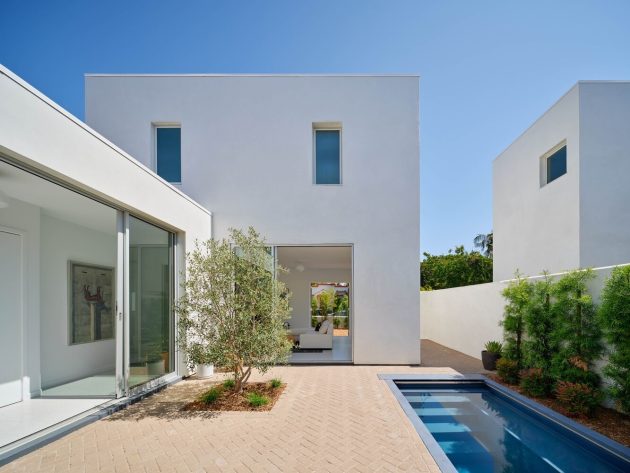Project: Santa Monica Courtyard Houses
Architects: Inaba Williams Architects
Location: Santa Monica, California, United States
Area: 3,900 sf
Year: 2022
Photographs by: Brandon Shigeta
Santa Monica Courtyard Houses by Inaba Williams Architects
“Title 24,” California’s Building Energy Efficiency Standards, has inspired the innovative design of these net-zero homes in Southern California. Rather than replicating the midcentury glass house style, which often requires energy-intensive materials and high power consumption, the Santa Monica Courtyard Houses adopt a new approach.
They prioritize energy efficiency by limiting window usage to just 20% of the surface area while strategically placing them around the main living areas to maximize daylight. These homes also reduce their indoor footprint, focusing on outdoor living spaces framed by setback perimeter walls.
The central courtyard becomes a hub for outdoor activities, featuring a dining area, fire pit, and tranquil zen garden. These homes represent a model for sustainable, energy-efficient living in the years to come.
“Title 24” (California’s Building Energy Efficiency Standards) inspired the design of the net-zero homes. We see the state’s recently implemented code as an opportunity to reinvent the Southern California single-family dwelling.
While a midcentury Case Study-type glass house is still possible under Title 24, that home would require high embodied energy materials and consume lots of power, undermining the Energy Standards’ aims. Instead, the Santa Monica Courtyard Houses assume a different look and feel that is more suitable to current climate conditions. Having far fewer windows, the outside form reduces the amount of heat gain and lowers energy use while still allowing residents to enjoy indoor-outdoor living – the hallmark of great Angeleno homes.
Following the Title 24 option to use glass on just 20% of the surface area, we concentrated the limited area of windows and glazed doors around the main living spaces. Rooms facing the courtyard receive generous amounts of daylight from three sides. And, in the two stairwells, skylights and windows are paired together to
Enclosing less floor area than the maximum allowed by code, the side-by-side homes increase the amount of space people can enjoy outside while decreasing the amount of inside area that requires heating and cooling energy. The perimeter walls setback to frame spaces for opening air living: the centerpiece of it all is the courtyard which is complemented by a dining area, fire pit, and zen garden.
Like the buildings which introduced new architectural forms after the passage of New York’s 1916 zoning resolution, we hope the Santa Monica Courtyard Houses serve as a model building that can be repeated and refined in the years to come to dramatize these vertical volumes.


























